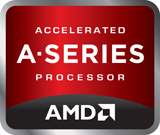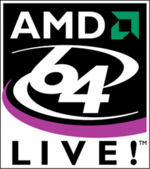
Advanced Micro Devices, Inc. is an American multinational semiconductor company based in Santa Clara, California, that develops computer processors and related technologies for business and consumer markets.

ATI Technologies Inc. was a Canadian semiconductor technology corporation based in Markham, Ontario, that specialized in the development of graphics processing units and chipsets. Founded in 1985 as Array Technology Inc., the company listed publicly in 1993 and was acquired by AMD in 2006. As a major fabrication-less or fabless semiconductor company, ATI conducted research and development in-house and outsourced the manufacturing and assembly of its products. With the decline and eventual bankruptcy of 3dfx in 2000, ATI and its chief rival Nvidia emerged as the two dominant players in the graphics processors industry, eventually forcing other manufacturers into niche roles.
Radeon is a brand of computer products, including graphics processing units, random-access memory, RAM disk software, and solid-state drives, produced by Radeon Technologies Group, a division of AMD. The brand was launched in 2000 by ATI Technologies, which was acquired by AMD in 2006 for US$5.4 billion.

Geode was a series of x86-compatible system-on-a-chip microprocessors and I/O companions produced by AMD, targeted at the embedded computing market.

A free and open-source graphics device driver is a software stack which controls computer-graphics hardware and supports graphics-rendering application programming interfaces (APIs) and is released under a free and open-source software license. Graphics device drivers are written for specific hardware to work within a specific operating system kernel and to support a range of APIs used by applications to access the graphics hardware. They may also control output to the display if the display driver is part of the graphics hardware. Most free and open-source graphics device drivers are developed by the Mesa project. The driver is made up of a compiler, a rendering API, and software which manages access to the graphics hardware.
The AMD mobile platform is an open platform for laptops from AMD. Though little marketing was done on this platform, it has been competing with the Centrino platform in the segment to gain more marketshare. Each platform has its own specification, catching up the latest technology developments. Since the acquisition of ATI, AMD began to include Mobility Radeon GPUs and AMD chipsets as part of the requirements of the mobile platform; the first of such platforms is the Puma platform.
ATI Avivo is a set of hardware and low level software features present on the ATI Radeon R520 family of GPUs and all later ATI Radeon products. ATI Avivo was designed to offload video decoding, encoding, and post-processing from a computer's CPU to a compatible GPU. ATI Avivo compatible GPUs have lower CPU usage when a player and decoder software that support ATI Avivo is used. ATI Avivo has been long superseded by Unified Video Decoder (UVD) and Video Coding Engine (VCE).

AMD Accelerated Processing Unit (APU), formerly known as Fusion, is a series of 64-bit microprocessors from Advanced Micro Devices (AMD), combining a general-purpose AMD64 central processing unit (CPU) and 3D integrated graphics processing unit (IGPU) on a single die.
The AMD 700 chipset series is a set of chipsets designed by ATI for AMD Phenom processors to be sold under the AMD brand. Several members were launched in the end of 2007 and the first half of 2008, others launched throughout the rest of 2008.
The AMD 690 chipset series is an integrated graphics chipset family which was developed and manufactured by AMD subsidiary ATI for both AMD and Intel platforms focusing on both desktop and mobile computing markets. The corresponding chipset for the Intel platform has a marketing name of Radeon Xpress 1200 series.
Unified Video Decoder is the name given to AMD's dedicated video decoding ASIC. There are multiple versions implementing a multitude of video codecs, such as H.264 and VC-1.
The Evergreen series is a family of GPUs developed by Advanced Micro Devices for its Radeon line under the ATI brand name. It was employed in Radeon HD 5000 graphics card series and competed directly with Nvidia's GeForce 400 Series.

A nettop is a small-sized, inexpensive, low-power, legacy-free desktop computer designed for basic tasks such as web browsing, accessing web-based applications, document processing, and audio/video playback. The word nettop is a portmanteau of network and desktop. It is the desktop counterpart of the netbook. Modern mini PCs or small form factor PCs can be much more powerful, being equipped with high-end laptop components or mid-range desktop components.
The HP Pavilion dv2 was a series of 12" notebooks manufactured by Hewlett-Packard Company.
Lenovo’s line of Essential desktops is a collection of budget-conscious machines designed for consumers, and advertised as being "affordable, space saving, and energy efficient". The Essential desktop line is different from both Lenovo’s ThinkCentre line and Lenovo’s IdeaCentre line. Lenovo defines its ThinkCentre desktops as business-oriented computers, while the IdeaCentre desktops are meant primarily for entertainment. The Essential range of desktops can be categorized as being between the two – meant more for ordinary everyday use.
Heterogeneous System Architecture (HSA) is a cross-vendor set of specifications that allow for the integration of central processing units and graphics processors on the same bus, with shared memory and tasks. The HSA is being developed by the HSA Foundation, which includes AMD and ARM. The platform's stated aim is to reduce communication latency between CPUs, GPUs and other compute devices, and make these various devices more compatible from a programmer's perspective, relieving the programmer of the task of planning the moving of data between devices' disjoint memories.
The graphics processing unit (GPU) codenamed the Radeon R600 is the foundation of the Radeon HD 2000/3000 series and the FireGL 2007 series video cards developed by ATI Technologies.
The graphics processing unit (GPU) codenamed Radeon R600 is the foundation of the Radeon HD 2000 series and the FireGL 2007 series video cards developed by ATI Technologies. The HD 2000 cards competed with nVidia's GeForce 8 series.

Imageon was a series of media coprocessors and mobile chipsets produced by ATI in 2002–2008, providing graphics acceleration and other multimedia features for handheld devices such as mobile phones and Personal Digital Assistants (PDAs). AMD later sold the Imageon mobile handheld graphics division to Qualcomm in 2009, where it was used exclusively inside their Snapdragon SoC processors under the Adreno brand name.
Video Code Engine is AMD's video encoding application-specific integrated circuit implementing the video codec H.264/MPEG-4 AVC. Since 2012 it was integrated into all of their GPUs and APUs except Oland.








